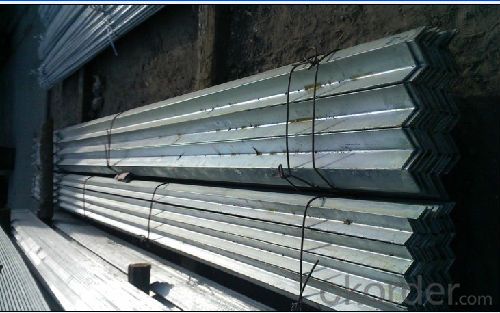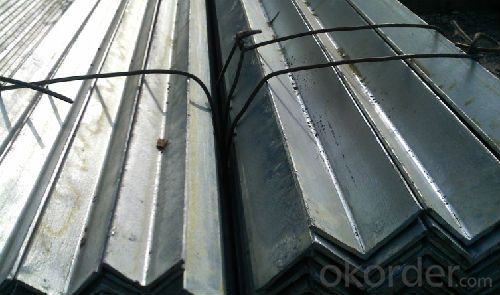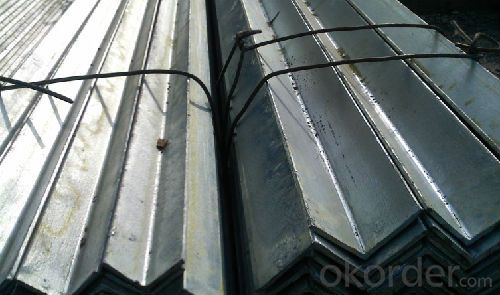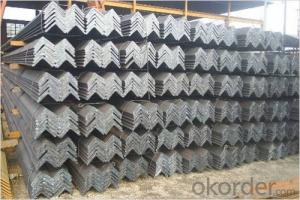Hot Rolled Steel Equal Steel Angle Q235 Q235 SS400
- Loading Port:
- Tianjin
- Payment Terms:
- TT or LC
- Min Order Qty:
- 27 m.t.
- Supply Capability:
- 35000 m.t./month
OKorder Service Pledge
OKorder Financial Service
You Might Also Like
Product Description:
OKorder is offering Hot Rolled Steel Equal Steel Angle Q235 Q235 SS400 at great prices with worldwide shipping. Our supplier is a world-class manufacturer of steel, with our products utilized the world over. OKorder annually supplies products to European, North American and Asian markets. We provide quotations within 24 hours of receiving an inquiry and guarantee competitive prices.
Product Applications:
Hot Rolled Steel Equal Steel Angle Q235 Q235 SS400 are ideal for structural applications and are widely used in the construction of buildings and bridges, and the manufacturing, petrochemical, and transportation industries.
Product Advantages:
OKorder's Hot Rolled Steel Equal Steel Angle Q235 Q235 SS400 are durable, strong, and resist corrosion.
Main Product Features:
· Premium quality
· Prompt delivery & seaworthy packing (30 days after receiving deposit)
· Corrosion resistance
· Can be recycled and reused
· Mill test certification
· Professional Service
· Competitive pricing
Product Specifications:
Specifications of Angle Steel
1. Invoicing on theoretical weight or actual weight as customer request.
2. Length: 6m, 9m, 12m.
3. Sizes:
Size(mm) | Mass(Kg/m) | Size(mm) | Mass(Kg/m) |
50*50*4 | 3.059 | 63*63*5 | 4.822 |
50*50*5 | 3.77 | 63*63*6 | 5.721 |
50*50*6 | 4.465 | |
Alloy No | Grade | Element (%) | |||||
C | Mn | S | P | Si | |||
|
|
|
|
|
|
| |
Q235 | B | 0.12—0.20 | 0.3—0.7 | ≤0.045 | ≤0.045 | ≤0.3 | |
|
|
|
|
|
|
| |
Alloy No | Grade | Yielding strength point( Mpa) | |||||
Thickness (mm) | |||||||
≤16 | >16--40 | >40--60 | >60--100 | ||||
≥ | |||||||
|
|
|
|
|
| ||
Q235 | B | 235 | 225 | 215 | 205 | ||
Alloy No | Grade | Tensile strength (Mpa) | Elongation after fracture (%) | ||||
Thickness (mm) | |||||||
| ≤16 | >16--40 | >40--60 | >60--100 | |||
≥ | |||||||
|
|
|
|
|
|
| |
Q235 | B | 375--500 | 26 | 25 | 24 | 23 | |
Packaging & Delivery of Hot Rolled Steel Equal Steel Angle Q235 Q235 SS400
1. Packing: it is nude packed in bundles by steel wire rod
2. Bundle weight: not more than 3.5MT for bulk vessel; less than 3 MT for container load
3. Marks:
Color marking: There will be color marking on both end of the bundle for the cargo delivered by bulk vessel. That makes it easily to distinguish at the destination port.
Tag mark: there will be tag mark tied up on the bundles. The information usually including supplier logo and name, product name, made in China, shipping marks and other information request by the customer.
If loading by container the marking is not needed, but we will prepare it as customer request.
4. Transportation: the goods are delivered by truck from mill to loading port, the maximum quantity can be loaded is around 40MTs by each truck. If the order quantity cannot reach the full truck loaded, the transportation cost per ton will be little higher than full load.
5. Delivered by container or bulk vessel
FAQ:
Q1: Why buy Materials & Equipment from OKorder.com?
A1: All products offered byOKorder.com are carefully selected from China's most reliable manufacturing enterprises. Through its ISO certifications, OKorder.com adheres to the highest standards and a commitment to supply chain safety and customer satisfaction.
Q2: How do we guarantee the quality of our products?
A2: We have established an advanced quality management system which conducts strict quality tests at every step, from raw materials to the final product. At the same time, we provide extensive follow-up service assurances as required.
Q3: How soon can we receive the product after purchase?
A3: Within three days of placing an order, we will begin production. The specific shipping date is dependent upon international and government factors, but is typically 7 to 10 workdays.
Q4: What makes stainless steel stainless?
A4: Stainless steel must contain at least 10.5 % chromium. It is this element that reacts with the oxygen in the air to form a complex chrome-oxide surface layer that is invisible but strong enough to prevent further oxygen from "staining" (rusting) the surface. Higher levels of chromium and the addition of other alloying elements such as nickel and molybdenum enhance this surface layer and improve the corrosion resistance of the stainless material.
Q5: Can stainless steel rust?
A5: Stainless does not "rust" as you think of regular steel rusting with a red oxide on the surface that flakes off. If you see red rust it is probably due to some iron particles that have contaminated the surface of the stainless steel and it is these iron particles that are rusting. Look at the source of the rusting and see if you can remove it from the surface.
Images:



- Q:Can steel angles be used for fencing?
- Indeed, steel angles possess the potential for fencing. The utilization of steel angles is prevalent in fencing applications owing to their robustness, endurance, and adaptability. They furnish a solid structure for the fence, guaranteeing steadiness and security. The installation of steel angles is a task easily accomplished, and their configuration permits an array of fence designs and heights. Moreover, they exhibit resistance to rust and corrosion, rendering them appropriate for outdoor utilization. In summary, steel angles emerge as a favored option for fencing endeavors due to their structural soundness and enduring effectiveness.
- Q:What is the maximum length of a continuous steel angle?
- The maximum length of a continuous steel angle is determined by several factors, including the size and weight of the angle, as well as the limitations of transportation and handling. In general, the maximum length of a continuous steel angle is typically limited to the maximum length that can be safely transported and handled by equipment such as cranes or forklifts. This can vary depending on the specific capabilities of the equipment being used and any restrictions imposed by the transportation infrastructure. Additionally, the length of a continuous steel angle may also be limited by the manufacturing process, as longer lengths may be more difficult to produce or may require specialized equipment. Ultimately, the maximum length of a continuous steel angle will depend on a combination of these factors and should be determined based on the specific project requirements and constraints.
- Q:What are the different methods of connecting steel angles to other structural elements?
- Different methods exist for connecting steel angles to other structural elements, depending on the specific application and load requirements at hand. One method commonly employed is welding, which involves the fusion of the steel angle to the other structural element through the application of intense heat. This results in a robust and enduring connection capable of withstanding high loads. Welding proves particularly useful when a permanent connection is necessary and substantial load requirements are present. Another method is bolting, wherein bolts and nuts are utilized to secure the steel angle to the other structural element. This approach allows for easy disassembly and reassembly if required, offering greater flexibility compared to welding. Bolting is typically chosen when an adjustable connection is desired or when the load requirements are relatively lower. Riveting represents an additional option for connecting steel angles to other structural elements. This method entails inserting a metal pin, known as a rivet, through aligned holes in both the steel angle and the other element, with the end of the rivet deformed to secure it in place. Riveting delivers a sturdy and dependable connection, although it may demand more time and labor compared to welding or bolting. Additionally, adhesive bonding can also be employed to connect steel angles to other structural elements. This technique utilizes specialized adhesives capable of bonding the surfaces of both the steel angle and the other element together. Adhesive bonding provides a strong and uniform connection, making it ideal for applications where aesthetics matter or when joining dissimilar materials is necessary. In summary, the various methods for connecting steel angles to other structural elements encompass welding, bolting, riveting, and adhesive bonding. The choice of method relies on factors such as load requirements, desired flexibility, ease of assembly and disassembly, and the specific application at hand.
- Q:Can steel angles be used in earthquake-resistant building designs?
- Yes, steel angles can be used in earthquake-resistant building designs. Steel angles are commonly used in construction due to their strength and stability. When properly engineered and integrated into the design, steel angles can provide additional support and reinforcement to the building structure, making it more resistant to seismic forces during an earthquake.
- Q:What are the considerations for selecting the appropriate steel angle connection type?
- To ensure the structural integrity and stability of the connection, it is crucial to take several considerations into account when selecting the appropriate steel angle connection type. Firstly, the connection type should have the capacity to withstand anticipated loads, including dead load, live load, wind load, and seismic load. It should efficiently transfer these loads without causing any failure or compromise in the overall structure. Secondly, the connection type should meet the specific structural requirements of the project, such as the desired level of stiffness, flexibility, or rigidity. This includes considering factors like the connection's ability to resist deflection or movement under different loading conditions. Moreover, safety and reliability should be prioritized when choosing the connection type. It should provide a secure and durable connection that will not fail or deteriorate over time. Factors such as material properties, corrosion resistance, and maintenance requirements should be taken into consideration to ensure long-term performance. Cost-effectiveness is also important. The selected connection type should balance material and labor requirements while meeting necessary performance standards. Factors like ease of fabrication, installation, and maintenance can help determine the most cost-effective option. Compatibility and availability are other crucial factors. The connection type should be compatible with existing steel members and readily available in the market to avoid delays or supply chain issues during construction. Additionally, any specific design or construction constraints, such as space limitations or access restrictions, should be considered. The connection type should accommodate these constraints without compromising the overall structural integrity. Lastly, it is essential to ensure that the selected connection type complies with applicable building codes, standards, and regulations. This guarantees the safety and legal compliance of the structure. By carefully considering these factors, engineers and designers can choose the appropriate steel angle connection type that best meets the project's requirements in terms of load capacity, structural integrity, safety, cost-effectiveness, and compliance with codes and regulations.
- Q:Are there any industry standards or certifications for steel angles?
- Yes, there are industry standards and certifications for steel angles. The most widely recognized standard for steel angles is the American Society for Testing and Materials (ASTM) standard. The ASTM A36 specification is commonly used for structural steel angles and provides specific requirements for chemical composition, mechanical properties, and dimensional tolerances. In addition to ASTM, other organizations such as the American Institute of Steel Construction (AISC) and the Steel Joist Institute (SJI) provide guidelines and standards for steel angles used in construction and structural engineering applications. These standards ensure that steel angles meet specific requirements for quality, strength, and performance. Furthermore, certifications such as ISO 9001:2015 and ISO 14001:2015 are widely recognized in the steel industry, indicating that a manufacturer has implemented a quality management system and meets environmental management standards. It is important for manufacturers, suppliers, and construction professionals to adhere to these industry standards and certifications to ensure the reliability and safety of steel angles in various applications.
- Q:What are the different methods of surface preparation for steel angles before painting?
- There are various techniques available for preparing steel angles before painting, and the method chosen depends on the condition of the steel surface and the desired level of paint adhesion and durability. One widely used technique is abrasive blasting, also known as sandblasting. This entails directing abrasive particles towards the steel surface to eliminate rust, mill scale, and other contaminants. Abrasive blasting not only cleans the surface but also creates a rough texture, enhancing paint adhesion. Chemical cleaning is another method employed to prepare steel angles for painting. It involves utilizing chemical solutions or solvents to eliminate grease, oil, and other organic contaminants. This technique is particularly effective for stubborn contaminants that cannot be removed by abrasive blasting alone. Mechanical cleaning techniques, such as wire brushing or grinding, can be utilized to eliminate loose rust, scale, and old paint. These methods are suitable for smaller areas or localized rust spots. In certain instances, power tool cleaning may suffice. This involves using power tools like grinders, sanders, or wire brushes to clean the steel surface. However, it is important to ensure that these tools do not create a polished or smooth surface, as this can hinder paint adhesion. After the surface has been cleaned, it is crucial to remove any remaining contaminants by wiping the surface with a solvent or a clean cloth soaked in a suitable solvent. This step guarantees that the surface is free from any residual contaminants that could affect paint adhesion. Lastly, before painting, it is essential to prime the steel angles. Primers provide additional corrosion protection and enhance the adhesion of the topcoat. The choice of primer depends on the specific project requirements, such as exposure to harsh weather conditions or chemical exposure. In conclusion, the various methods of surface preparation for steel angles before painting include abrasive blasting, chemical cleaning, mechanical cleaning, power tool cleaning, solvent wiping, and priming. By selecting the appropriate method, one can ensure that the paint adheres well to the steel surface and provides long-lasting protection against corrosion.
- Q:What are the different corrosion protection methods for steel angles?
- There exists a range of corrosion protection methods for steel angles, which depend on the particular application and environmental conditions. Some commonly employed methods are as follows: 1. Galvanization: Coating the steel angles with a layer of zinc is a highly effective method of corrosion protection. The zinc layer acts as a sacrificial anode, corroding in place of the underlying steel. 2. Paint coatings: The application of a high-quality paint coating to the steel angles offers effective corrosion protection. The paint acts as a barrier, preventing moisture and corrosive substances from reaching the steel surface. 3. Powder coating: Similar to paint coatings, powder coating involves the application of a dry powder to the steel angles, followed by baking to create a durable and corrosion-resistant finish. 4. Epoxy coatings: For steel angles exposed to harsh environments or aggressive chemicals, epoxy coatings are commonly used. These coatings exhibit excellent adhesion and corrosion resistance. 5. Cathodic protection: This method involves the utilization of a sacrificial anode or impressed current to safeguard the steel angles from corrosion. The anode corrodes instead of the steel, providing long-lasting protection. 6. Barrier coatings: Barrier coatings, such as polyethylene or PVC wraps, create a physical barrier between the steel angles and the surrounding environment. This prevents moisture and corrosive substances from reaching the surface. 7. Hot-dip galvanizing: In this method, the steel angles are immersed in a bath of molten zinc, resulting in the formation of a thick zinc coating that offers superb corrosion protection. When selecting a corrosion protection method for steel angles, it is vital to consider the specific requirements of the application. Factors such as the environment, expected service life, and budget must be taken into account to ensure the most suitable method is chosen.
- Q:How do steel angles perform under vibration or resonance conditions?
- Steel angles are known for their excellent structural properties, including their ability to withstand vibrations and resonance conditions. When subjected to vibrations, steel angles exhibit high stiffness and damping characteristics, which enable them to effectively dissipate the energy generated by the vibrations. This behavior is due to the inherent material properties of steel, such as its high strength and rigidity. Under resonance conditions, steel angles also perform well. Resonance occurs when the frequency of the external excitation matches the natural frequency of the steel angle. In such cases, the steel angle may experience amplified vibrations, which can potentially lead to structural failure if not properly addressed. However, steel angles are designed and fabricated with considerations for resonance in mind, ensuring that they can withstand and mitigate the effects of resonance. To enhance the performance of steel angles under vibration or resonance conditions, engineers may employ various techniques. These can include adding damping materials or devices to absorb or dissipate the vibrational energy, modifying the geometric properties of the steel angle to alter its natural frequency, or employing vibration isolation systems to reduce the transmission of vibrations to the steel angle. Overall, steel angles are well-suited for applications requiring resistance to vibrations or resonance conditions. Their high strength, stiffness, and damping properties enable them to effectively withstand and mitigate the effects of vibrations, ensuring the integrity and stability of the structure in which they are used.
- Q:What is the typical thickness of a steel angle?
- The typical thickness of a steel angle can vary depending on the specific application and size of the angle. However, common thicknesses range from 1/8 inch to 3/8 inch.
1. Manufacturer Overview |
|
|---|---|
| Location | |
| Year Established | |
| Annual Output Value | |
| Main Markets | |
| Company Certifications | |
2. Manufacturer Certificates |
|
|---|---|
| a) Certification Name | |
| Range | |
| Reference | |
| Validity Period | |
3. Manufacturer Capability |
|
|---|---|
| a)Trade Capacity | |
| Nearest Port | |
| Export Percentage | |
| No.of Employees in Trade Department | |
| Language Spoken: | |
| b)Factory Information | |
| Factory Size: | |
| No. of Production Lines | |
| Contract Manufacturing | |
| Product Price Range | |
Send your message to us
Hot Rolled Steel Equal Steel Angle Q235 Q235 SS400
- Loading Port:
- Tianjin
- Payment Terms:
- TT or LC
- Min Order Qty:
- 27 m.t.
- Supply Capability:
- 35000 m.t./month
OKorder Service Pledge
OKorder Financial Service
Similar products
New products
Hot products
Related keywords


























